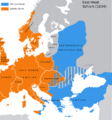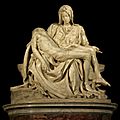Early Christianity facts for kids
Early Christianity refers to the first few centuries of the Christian faith. This period began around the time of Jesus' death (about 26-36 AD) and lasted until the year 325 AD. This was when an important meeting called the First Council of Nicaea took place.
Historians have learned a lot about the first Christian communities, especially since the 1800s. They have found old writings like the Didache and the Gospel of Thomas. These discoveries help us understand how Christianity started and grew.
Contents
The Start of Christianity
At the very beginning, the Christian church was centered in Jerusalem. It met in a special "upper room," which some believe is where the Cenacle stands today. Key leaders in this early community included James, Peter, and John.
Spreading the Message
The main source of information about this early time, often called the Apostolic Age (from about 30 AD to 100 AD), is the Acts of the Apostles in the Bible. After Jesus told his followers to spread his teachings, the Apostles began their missions.
One of the most important figures was Paul of Tarsus. He was known as the "Apostle to the Gentiles," meaning he focused on sharing Christianity with non-Jewish people. Through his travels, Christianity spread to major cities in the Hellenistic world, like Alexandria and Antioch. It also reached Rome and even areas beyond the Roman Empire.
Becoming Known as "Christians"
The name "Christian" was first used for followers of Jesus in the city of Antioch. This is mentioned in the Bible in Acts 11:26.
The New Testament part of the Bible includes many letters written by Paul. These letters were sent to early churches in places like Thessalonica and Corinth between the years 50 and 62 AD. You can also read about the Seven Churches of Asia in the Bible.
Early Christian Writings
Early Christians respected the Jewish Scriptures, which are now part of the Old Testament. They often used the Septuagint, a Greek translation of these scriptures that was common among Greek-speaking Jews. Aramaic-speaking Christians used the Targums. Over time, Christians also started adding their own writings, which eventually became the New Testament.
Images for kids
-
The eastern Mediterranean region in the time of Paul the Apostle
-
St. Lawrence (martyred 258) before Emperor Valerianus by Fra Angelico
-
A page from Papyrus 46, an early collection of Paul's letters from the 3rd century.
-
An Eastern Roman mosaic showing a basilica with towers, mounted with Christian crosses, 5th century, Louvre.
-
A mosaic of Justinian I in the church of San Vitale, Ravenna, Italy.
-
Henry IV at the gate of Canossa, by August von Heyden.
-
St. Cyril and St. Methodius monument on Mt. Radhošť.
-
Painting of Jan Hus in Council of Constance by Václav Brožík.
-
Michelangelo's Pietà (1498–99) in St. Peter's Basilica, Vatican City.
-
Philipp Spener, the founder of Pietism.
-
Churches of the Moscow Kremlin, as seen from the Balchug.
See also
 In Spanish: Cristianismo primitivo para niños
In Spanish: Cristianismo primitivo para niños





















